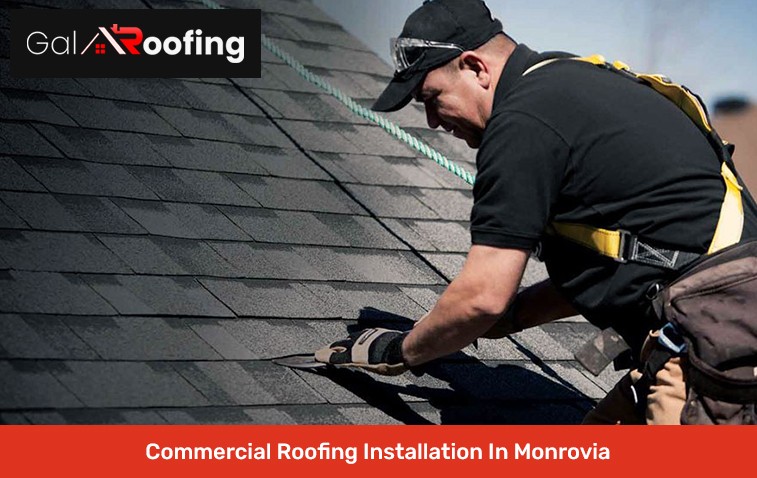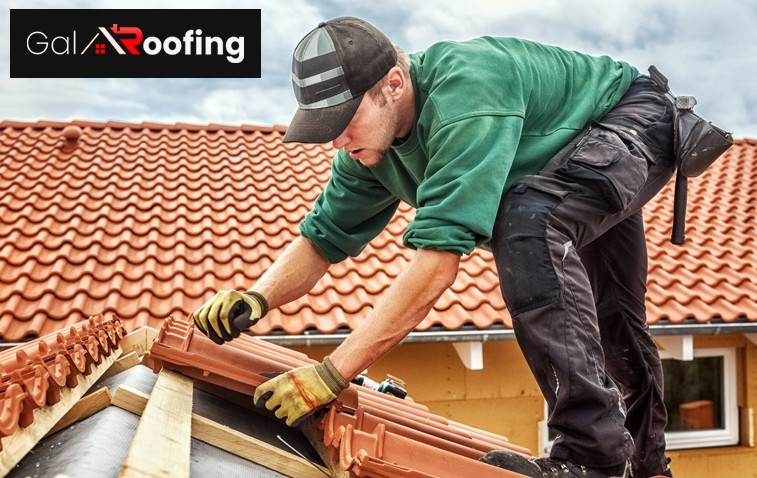Commercial Roofing Installation in Monrovia
Hiring a professional for commercial roofing installation in Monrovia is important when it comes to installing a new roof for your commercial building. When you get the services from Gal Roofing, you get high-quality and long-lasting results.
As professional roofing contractors in Monrovia, we have the expertise and experience to provide efficient and effective roofing installation services while adhering to safety regulations and building codes. Get the help that you need to choose the right roofing materials that meet your specific needs and budget.

Our Services
There are several different commercial roofing installation services that are available, including:
Built-Up Roofing (BUR)
This type of roofing involves the application of multiple layers of bitumen and ply sheets to create a durable and long-lasting roofing system
Single-Ply Roofing
This type of roofing involves the installation of a single layer of membrane, such as EPDM or TPO, which provides excellent waterproofing and energy efficiency.
Modified Bitumen Roofing
This type of roofing involves the application of a modified bitumen membrane, which is made from asphalt and other materials. This type of roofing is known for its durability and resistance to extreme temperatures.
Metal Roofing
Metal roofing is becoming increasingly popular in commercial roofing installations due to its durability, energy efficiency, and aesthetic appeal.
| Roofing Material | Advantages | Ideal Places to Use | Average Cost (per square foot) |
|---|---|---|---|
| Built-Up Roofing (BUR) | Durable, long-lasting, fire-resistant | Low-slope or flat roofs | $3-$7 |
| Single-Ply Roofing | Lightweight, easy to install, energy-efficient | Low-slope roofs | $3-$8 |
| Modified Bitumen Roofing | Durable, flexible, easy to repair | Low-slope or flat roofs | $4-$8 |
| Metal Roofing | Durable, long-lasting, energy-efficient, recyclable | Sloped roofs | $5-$12 |
Getting Permits
The specific permits required for commercial roofing installation in Monrovia, California may vary based on the scope and specifics of the project, as well as local building codes and regulations. However, here are some common permits that may be required:

Building Permit
This permit is typically required for any new construction or major renovations, including roofing installations. It ensures that the work complies with local building codes and safety standards.
Roofing Permit
You will need a separate permit specifically for roofing installations. This permit may require information about the type of roofing material, installation methods, and other details.
Electrical Permit
If the roofing project involves any electrical work, such as installing new lighting or ventilation systems, an electrical permit may be required.
Mechanical Permit
If the roofing project involves any mechanical work, such as installing HVAC systems, a mechanical permit may be required
Environmental Permit
Depending on the location and scope of the project, an environmental permit may be required to ensure compliance with local environmental regulations.
Things to Do to Get a Commercial Roofing Installation Permit in Monrovia
To obtain a permit for commercial roofing installation in Monrovia, California, you typically need to follow these steps:
Contact the Monrovia Building and Safety Division
Start by contacting the Monrovia Building and Safety Division to determine the specific requirements and procedures for obtaining a commercial roofing installation permit.
Prepare the required documentation
The Building and Safety Division will typically require specific documentation as part of the permit application process, such as construction plans, engineering reports, and permit applications. Make sure to provide accurate and complete information to expedite the process.
Here are the documents that you need.
- Completed permit application form: The permit application form is typically required to provide details about the roofing project, such as the location, scope, and purpose of the work.
- Construction plans: The construction plans typically include drawings or blueprints that provide details about the roofing materials, design, dimensions, and other important specifications.
- Engineering reports: Engineering reports may be required to ensure that the roofing project complies with local building codes, safety standards, and engineering requirements.
- Energy calculations: You might require energy calculations to ensure that the roofing project meets energy efficiency standards.
Submit the application
Once you have prepared all the required documentation, submit your application to the Monrovia Building and Safety Division. The application will typically be reviewed by the Building and Safety staff to ensure compliance with local building codes and safety standards.
Pay the permit fee
The permit fee for commercial roofing installation in Monrovia varies based on the scope and specifics of the project. Make sure to pay the required fee to obtain the permit.
Obtain the permit
Once your application is approved and the permit fee is paid, you can obtain the commercial roofing installation permit from the Monrovia Building and Safety Division.
Schedule inspections
During the roofing installation process, the Building and Safety Division will typically require inspections at various stages to ensure compliance with building codes and safety standards. Make sure to schedule these inspections as required.
The Process of Installing Built-Up Roofing (BUR)
We offer complete support for built-up commercial roofing installation in Monrovia. Installing Built Up Roofing (BUR) for commercial buildings typically involves the following steps:
Surface Preparation
Before starting the installation process, the surface of the building’s roof should be cleaned, dried, and prepared for installation. Any old roofing materials, debris, and loose or damaged substrate should be removed
Base Layer Installation
The first layer of the Built Up Roofing system is typically a base layer, consisting of a layer of roofing felt, asphalt or tar, and fiberglass or polyester reinforcement. This layer should be installed with a layer of hot asphalt or adhesive, which should be rolled with a weighted roller to ensure proper adhesion.
Additional Layers
After the base layer is installed, additional layers of roofing felt and hot asphalt or adhesive should be added until the desired thickness is achieved. Each layer should be installed with care to ensure that there are no gaps or air pockets.
Flashing Installation
Flashing should be installed around any roof penetrations, such as vents or pipes, to ensure that there are no gaps or leaks. This is typically done by cutting and bending sheet metal to fit around the penetration and then securing it to the roof with screws or nails.
Surfacing
The final layer of the Built Up Roofing system is typically a surfacing layer, which can consist of gravel, mineral granules, or a reflective coating. This layer helps to protect the roofing materials from UV damage, and can also provide additional insulation.
Inspection
Once the roofing system is installed, it should be inspected to ensure that all layers are properly installed and that there are no gaps, leaks, or other issues.
The Process of Installing Modified Bitumen Roofing
Modified bitumen roofing is a popular choice for commercial buildings due to its durability and weather resistance. Here are the general steps involved in installing modified bitumen roofing:
Prepare the roof surface
The roof surface should be thoroughly cleaned and any existing roofing materials should be removed. The surface should be smooth and free of any debris
Install insulation
Insulation boards are installed over the roof surface to provide energy efficiency and protect the roof membrane.
Install base sheet
A base sheet is installed over the insulation boards. This sheet is usually made of fiberglass or polyester and is embedded in hot asphalt or cold adhesive.
Install modified bitumen membrane
The modified bitumen membrane is installed over the base sheet. The membrane is usually rolled out and then heat-welded to the base sheet using a torch. Alternatively, the membrane can be applied with a cold adhesive
Seal the seams
The seams between the modified bitumen membrane sheets are sealed with hot asphalt or cold adhesive to prevent water penetration.
Install flashing
Flashing is installed around roof penetrations, such as vents and chimneys, to prevent water from entering the building.
Install surfacing
A surfacing material is installed over the modified bitumen membrane to protect it from UV rays and to provide additional weather resistance. The surfacing material can be granules, gravel, or a reflective coating
Final inspection
Once the installation is complete, the roofing contractor will perform a final inspection to ensure that the roof is properly installed and watertight. Call us today!!!!